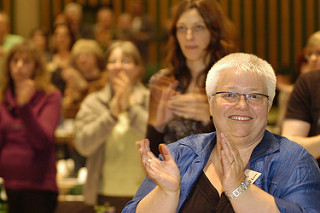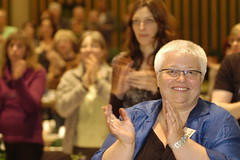Originally posted to Library Garden
It’s been a while since I blogged about the difference between Agents and Gatekeepers, wherein I quoted one of my favorite passages from Danny Meyer’s book, Setting the Table (the book is also a favorite of the Darien Library, according to John Blyberg; Char Booth has also expressed her appreciation for Meyer’s ideas.)
An agent makes things happen for others. A gatekeeper sets up barriers to keep people out. We’re looking for agents, and our staff members are responsible for monitoring their own performance: In that transaction, did I present myself as an agent or a gatekeeper? In the world of hospitality, there’s rarely anything in between.
I was recently reminded of the power of the “agent” concept while reading an article by Dan Pink on theories of motivation. The following quote caught my attention (It is from Maury Weinstein, founder of System Source, explaining to his sales staff why he did away with sales commissions):
We want you to be an agent for the customer rather than a salesperson.
Agent for the customer… Yes, yes, yes! I love this concept! Meyer says that hospitality exists when the customer believes the employee is on their side. He suggests that hospitality is present when something happens for you and is absent when something happens to you. I’m sure we can all quickly think of experiences where we felt that the person helping us was on our side, (was doing for us), and we can reflect on how that translated directly into a positive customer experience for us– even if the the interaction began because of a problem…
HOME DEPOT: CUSTOMER SERVICE TURNAROUND
 I’m coming to the end of an 18 month renovation to my house, which means I’ve spent an awful lot of time (and money) at The Home Depot over the past year and a half. During the last few months I’ve noticed a marked improvement in the customer service at the store. There are more employees available to help, there are always one or two greeters at the door, and employees who are just walking by smile and greet me.
I’m coming to the end of an 18 month renovation to my house, which means I’ve spent an awful lot of time (and money) at The Home Depot over the past year and a half. During the last few months I’ve noticed a marked improvement in the customer service at the store. There are more employees available to help, there are always one or two greeters at the door, and employees who are just walking by smile and greet me.
The most noticeable (and appreciated) phenomena though is how Home Depot has handled some recent problems with a damaged sink, and the return of a few (expensive) items that we did not need. On three different occasions, three different customer service agents took care of me, ensuring that the returns were taken, restocking fees were waived, and the stockroom was manually checked for a replacement part even though the computer said it wasn’t in stock (and the correct item was found saving me a trip to another store.)
This is some turnaround in customer service ethic for The Depot and apparently I’m not the only person who’s noticed. I can sum up my recent experiences by saying that in each interaction I felt that the Home Depot representative was on my side. They were friendly, patient (at times exceedingly patient), and consistent in their desire to meet my needs. I was not quoted policy, I was offered apologies. I was not told to wait in another line, I was brought over to the service desk where I could be more comfortable and given quicker service. I was not asked for receipts, I was asked for my address so they could look up my account and review my purchases. In other words, I was consistently served by agents rather than gatekeepers.
As I make my transition back to the world of public libraries, I will strive to keep this experience, and the ideas of hospitality and agency –of being on the side of my customers (both internal and external) – uppermost in my mind. Being on the side of the customer is a simple idea, but one that offers powerful guidance. And, I hope, powerful results.



